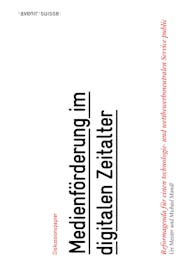Convergence between different types of media isn’t just heightened competition between traditional media providers, it’s also creating new rivalries, with the arrival of novel, often international, competitors, like telecoms groups, search engines and social media groups. The new framework is turning the existing system of state subsidies into an anachronism.
First, the current framework is specifically technology-orientated, in that print, radio and TV are subsidised separately, while the internet – the most important platform of the future – is excluded. That has consequences in terms of enshrining the current structure and distorting the market.
Second, the SRG’s current generous funding, based on an annual licence fee, increasingly distorts media competition. Its’ audio-visual content helps the public service broadcaster to crucially differentiate its online offering from private sector competitors. And third, public sector finance is counterproductive if the ensuing competitive distortions further accelerate media consolidation and reduce diversity.
Short term measures against SRG expansion
The current public funding of media providers is fundamentally controversial at a time of technological change. Avenir Suisse’s new discussion paper concedes Swiss politics and society are, and will remain, broadly in favour of some publically funded media. So the study focuses on solutions that might help transform the current subsidised system to meet the needs of a steadily converging media landscape. In the short term, that requires measures to hinder the creeping growth of the (licence fee funded) SRG. Two steps are proposed:
A Public Value Test: Following the example of the “Public Value Tests” already widely in use in Europe, Switzerland too should introduce an institutionalised ex ante mechanism to assess the SRG’s services. Such a procedure would check whether (new) SRG services correspond to the broadcaster’s public charter and what impact they have on private media providers (such as distorting competition or eclipsing the private sector’s own output). The two procedures would be conducted by two different, wholly independent, bodies.
A cap on earnings: The SRG has until now profited from steadily rising licence fee income, thanks to both rising annual levies and a growing population. The broadcaster’s wings could be clipped through limits on its profits, in the form of an “earnings cap” for licence revenues and advertising income. The “licence fee cap” could be indexed to inflation, while that on ad revenues to the aggregate budget of private sector media providers.
Subsidising content not technology
A profoundly changing media market requires longer term reforms of public funding for private media providers and prompts a fundamental reorganisation of the SRG itself. Cut price postage rates, lower rate value added tax and direct payments to radio and TV producers should be abolished and replaced with a financing system not biased towards any one platform.
Private Content Provider: The so called “Private Content Provider” model meets this need as far as the private sector is concerned. Like a co-operatively run news agency, content (text, live streams, videos, podcasts) would be made available to third parties at reasonable rates, without discrimination – and specifically without any explicit service mandate. This model, suitable only for a transitional period, would indirectly subsidise all media and would be aimed primarily at fostering diversity.
Public Content Provider: Establishing a subsidy system that would not favour any particular platform would, in the longer term, mean transforming the SRG into a “Public Content Provider” – a source solely of content, without its own distribution networks. Such a SRG would produce content, in various forms and in all Switzerland’s national languages, which would then be made available to private sector distributors. The Public Content Provider’s mandate would be exclusively to produce material, and its financing would come exclusively through the licence fee. This model would also allow private sector media to benefit indirectly from subsidies, irrespective of technology platform (print, radio, online), as such companies would receive fee-financed content for free and distribute it further. Any market distortions created through subsidies would be minimised, as the Public Content Provider would have access to neither end user nor to advertising revenues. The model would, moreover, simplify media subsidies by making other mechanisms, such as the Private Content Provider, obsolete.





